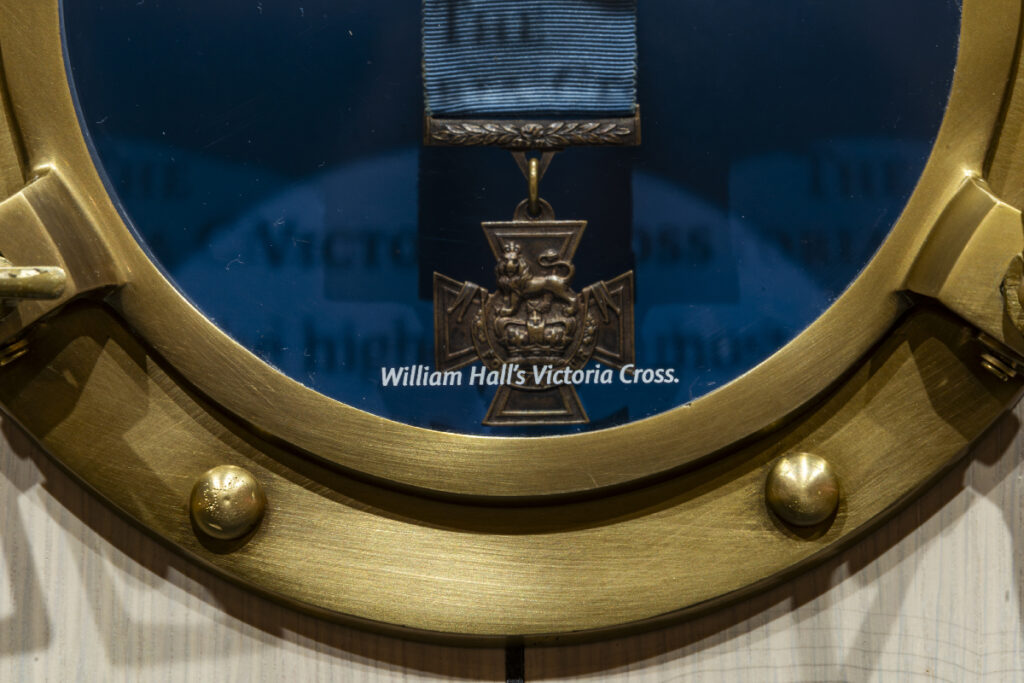
The Black Cultural Centre of Nova Scotia (BCC) recently unveiled a new exhibit honouring William Hall, the first Black person, the first Nova Scotian and one of the first Canadians to receive the British Empire’s highest award for bravery, the Victoria Cross.
A design team connected with NSCAD University was behind the new exhibit, which introduces visitors to Hall’s career and accomplishments and recognizes his achievements and impact after they were overlooked for much of Hall’s later life.
‘The new design brings his history and legacy to life’
Russell Grosse, CEO of the BCC, says the Centre had a duty to portray the full story of William Hall’s life.
“Often, historical remembrance involves a singular act that is cherished and celebrated. The refreshed William Hall exhibit expands upon this and creates a greater understanding of William Hall’s life, giving a wholesome review of this remarkable Canadian. The new design brings his history and legacy to life,” Grosse said.
Government leaders and members of the community attended the unveiling event, along with crew members from the HMCS William Hall and a team of designers connected with NSCAD University who researched, planned and designed this engaging permanent display. John deWolf (ICA in Design) was the lead, with interpretive planning and strategy by Robert Currie (RPT, Design) and graphic design contributions by Thomas Miko (BDes 1993) and recent NSCAD grad Maggie Abbott (BDes 2024).
‘As interpretative designers, getting the facts right is essential’

Robert Currie explains that the team reviewed hundreds of documents about William Hall’s life, learning more about his upbringing, service at sea and later life, reviewing hundreds of documents.
“We drew upon archival research, including his naval service records, newspaper accounts, correspondence regarding the work to recognize Hall and repatriate his Victoria Cross, and a considerable amount of recent work that clarifies important aspects of his life, including his full name and date of birth. As interpretative designers, getting the facts right is essential – all information must be carefully vetted and sourced.”
The team’s strategy was to visually communicate the major themes in Hall’s life with materials and colour, not simply text. Colours, textures and typefaces refer to major themes in his life, without attempting to reproduce actual artifacts or documents.
‘We wanted to show a more complex life story’

From the start, the goal was to show William Hall the person, Currie explains. The whole look and feel of the exhibit, how people move through it, was designed with care to give shape to a man who was resourceful, ambitious, and greatly admired.
The main face of the exhibit is dominated by Hall’s signature – establishing him as the author of his life story, and someone who had a basic education, able to read and write.
The exhibit includes “windows” that show vignettes of his life and places in Nova Scotia where he lived. Episodes from his naval career, and the Victoria Cross he won, are featured against a world map locating his far-flung exploits.
As visitors turn the corner, the story also “turns the corner” where the exhibit depicts his long-overdue recognition – on stamps, monuments, and as the namesake of a new naval vessel.
“With so little firsthand information about the man, we wanted to show a more complex life story, moving from left to right, from origins to the present day, without overloading the visitor with dates as a timeline-type presentation might,” says Currie.
The exhibit includes clapboard and windows that are evocative of the homes Hall grew up in and lived in his retirement, speaking to his Nova Scotian roots. The central portion of the exhibit evokes the deck of a ship, recalling his decades at sea. The team chose colours that symbolized elements of William Hall’s life – the dark blue comes from the colour reserved for the Victoria Cross ribbon; the pale blue is an homage to able seaman’s uniforms.
“Hall made his mark leading sailors and fighting battles across the globe, but we’ve set out, as much as we can, to reveal William Hall the man - not simply a naval hero, but someone whose character, as much as his achievements, deserves to be remembered by generations to come,” says Currie.
Visit the Black Cultural Centre and see the William Hall exhibit.
